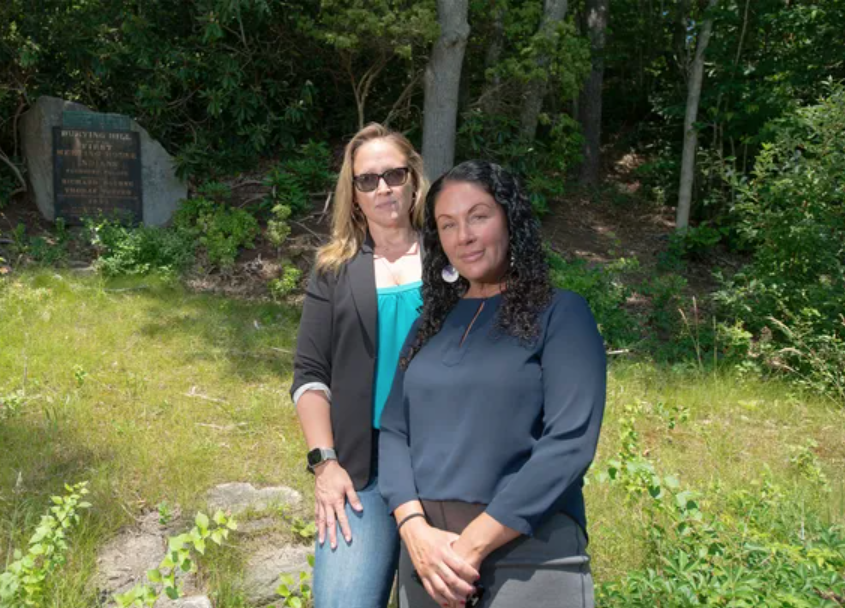What is buried at Burying Hill in Bourne? Herring Pond Wampanoag tribe wants to find out
July 19, 2024

Are apartments going up next to a Wampanoag tribal burying ground? (capecodtimes.com)
BOURNE — A burying ground of the Herring Pond Indians that has never been excavated is on a hill above the Cape Cod Canal.
The site on what is called Burying Hill is older than some more famous ancient sites across the globe, according to attorney and Herring Pond Wampanoag tribal citizen Jaime Hoctor.
“You used to be able to see the mounds, the rows and rows of people that are buried here,” Hoctor said during a recent visit. She motioned to faint trails that lead up the hill to a spring, and what was a meetinghouse established for tribal citizens in 1637.
The spot was an important place for the tribe, but it developed into an important place for the town as well, Hoctor said.
“It’s overgrown now and doesn’t reflect its history at all,” she said.
Homelands for the Herring Pond Wampanoag Tribe range from Plymouth to the nearby Cape Cod towns of Bourne and Sandwich.
Hoctor and Kerina Silva, also an attorney and Herring Pond Wampanoag Tribal citizen, have been researching the town-owned Burying Hill since December, after appealing an order of resource area delineation filed in November with the Bourne Conservation Commission by Steven Kahian, owner of 829 Scenic Highway.
Kahian intends to build a retail space and apartments, according to Herring Pond Wampanoag Chairwoman Melissa Ferretti. Ferretti is vice-chair of the Bourne Select Board.
Kahian told the Times he didn’t wish to comment.
The tribe can’t necessarily stop Kahian from building on abutting property, said Silva. But tribal members plan to ask for $7,000 in Community Preservation Act money at the fall town meeting to conduct ground-penetrating radar to learn more about who or what is buried at Burying Hill.
“Through our ancestors, we know our people are buried here,” said Hoctor. “We know they are there. We just don’t know where.”

What lies at Burying Hill?
Presently, Burying Hill is covered with trees, brush and thickets. The greenery largely hides a large boulder.
According to plaques on the boulder, Burying Hill is the site of the first meeting house for Indians in Plymouth Colony, and the meeting house was established by Richard Bourne and Thomas Tupper.
Get the Cape Confessions newsletter in your inbox.
Rachael Devaney takes a closer look at issues affecting Cape women.
Delivery: WedYour Email
Burying Hill was the original burying ground of the Herring Pond Indians, a branch of Wampanoags, who inhabited the district known as Comassamkanet, new Bournedale, Hoctor said. Many sachems, including a Wampanoag leader named Old Saul, are buried on Burying Hill, she said, based on newspaper clippings.
Hoctor and Silva have poured over clippings, and Betsy Keene’s “History of Bourne,” as well as a collection of Keene’s personal notes. They have found multiple references pointing to Burying Hill as a burial area for the tribe.
“There’s so much intertwined history that’s important for the whole community,” said Hoctor.

Thousands of tribal ancestors are estimated to be buried on Burying Hill and the surrounding area, Hoctor and Silva said. The grave sites spread into the area that’s now known as the Cape Cod Canal. When the canal was built between 1909 and 1916, Silva said, the bones of thousands of Wampanoag people were thrown away.
Can building on the site affect the tribe’s ability to unearth human remains?
About eight months ago, the tribe formed a Cultural Council. Part of what the council does is monitor order of resource area delineation filings that could affect tribal sacred sites.
On Dec. 24, a tribal member noticed Kahian’s filing on property that connects to sacred tribal burial grounds, Silva said. An engineer had surveyed the site and identified natural resources there. The council disagreed with the assessment and decided to appeal.
At a hearing at the property with the state Department of Environmental Protection, Tribal Medicine Man Troy Currence did a ceremony. Tribal Council member Hazel Currence gave testimony about her memories of the herring run, Silva said.
“Everybody came to the table,” she said.
The state environmental agency conducted a second assessment.
According to a superseding document on April 23, the state agency found that boundaries for bordering vegetated wetlands on the referenced plan were inaccurate. The review also included a focused assessment on riverfront areas where the Herring River flows through Foundry Pond and a cement fish ladder as well as a wetland area across the street and beyond the applicant’s property.

In the tribe’s opinion, the entire area around Burying Hill contains natural resources that warrant protection under the state Wetlands Protection Act. The site is a fragile cycle of waterways that supports species of plants, fish, birds, trees, along with other species that rely on the water systems that are contained on the property, said Silva.
Ultimately, said Silva, the state agency found that certain resources were not identified properly and the engineers were delineating resources not on the correct property.
What will become of Burying Hill?
The ultimate goal, Silva said, is to preserve Burying Hill as a culturally significant site.
ADVERTISING
“Whether it’s turned into a park or whether we can get that land back, the tribe will be happy as long as it’s preserved and not developed,” said Silva.
The research so far is not only fascinating, but also “a very personal journey as we continue to learn about our ancestors and the importance of our history and culture,” she said.
Rachael Devaney writes about community and culture. Reach her at rdevaney@capecodonline.com. Follow her on Twitter: @RachaelDevaney.
Thanks to our subscribers, who help make this coverage possible. If you are not a subscriber, please consider supporting quality local journalism with a Cape Cod Times subscription. Here are our subscription plans.